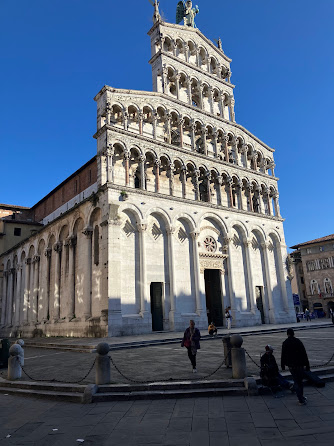Today we traveled to one of the most famous cities in Italy, Pisa, and to the leaning tower that made it so famous. The tower is actually the bell tower of the adjoining cathedral, and together with the baptistry the three buildings on the so-called Field of Miracles are indeed remarkable. “Be sure and take your cheesy picture,” our tour director joked. Although I have seen pictures of it all my life, I was still surprised by how much the leaning tower was indeed leaning. I enjoyed watching all of the tourists doing as we did, some of them more athletically than the rest of us, standing in various poses pretending to hold up the tower.
It was a shame that so many came to see the tower, remarkable though it is. According to the local specialist who gave us a tour of the cathedral, nineteen million people a year visit the tower, but few of them venture inside the beautiful cathedral or baptistry.Officially, the cathedral is the Cattedrale Metropolitana Primaziale di Santa Maria Assunta, begun in 1063 and completed in 1092. It, together with the bapistry, is also leaning slightly, although it is not as obvious as that of the tower which is about ten feet out of plumb due to the soft, unstable ground on which is was built. Efforts were made years ago to straighten the tower (because it was leaning to such a degree that it was hazardous to climb) by removing soil from one side, which succeeded in preventing it from leaning any more. Could they not have straightened it completely I asked? Yes, they likely could, our tour director confided in us. But who would visit the plumb tower of Pisa? And while these beautiful buildings were indeed unique and quite beautiful, it was a little depressing to encounter so many hawkers outside the walls of the Field of Miracles selling cheap trinkets – watches, key chains, and little plastic leaning towers.
After leaving Pisa, we traveled to the walled city of Lucca
for another walking tour with a local specialist. He was very informative, and we learned that
the city was the home of Puccini. There was
a beautiful cathedral here, too – the San Frediano Basilica – where relics
of Santa Zita are located.
The Comicon Festival had just ended in the city, and there were still posters and tents that were being taken down. The festival is the most important fair in Italy and Europe and is dedicated to comics, entertainment, board and role-playing games, and fantasy imagery, attracting over 300,000 visitors. I was relieved that the festival was over; it would have seemed jarringly out of place to see cosplaying visitors wandering these ancient streets.
Our guide made a joke about the election in the United States taking place tomorrow. We had almost forgotten (we voted early a few weeks ago) that it was election day. It seemed to us as if all of Europe was holding its breath about the election. Leaving NATO, or stopping aid to Ukraine, would have much more serious repercussions here than in our country.
On the way back to the Borgo di Cortafreda, our tour director
pointed out the remains of a Roman aqueduct along the highway, still standing after centuries. What a civilization the Roman Empire was, building these amazing structures, together
with roads, all over Europe, an incredible feat of engineering.
We were on our own for dinner, and while some of our travel companions walked to the nearby village where there was reportedly a Michelin-star restaurant, we opted to remain at our hotel, where we enjoyed a dinner of Tuscan soup and bread, so fresh and simple and absolutely delicious. And it paired well with regional red wine!





No comments:
Post a Comment